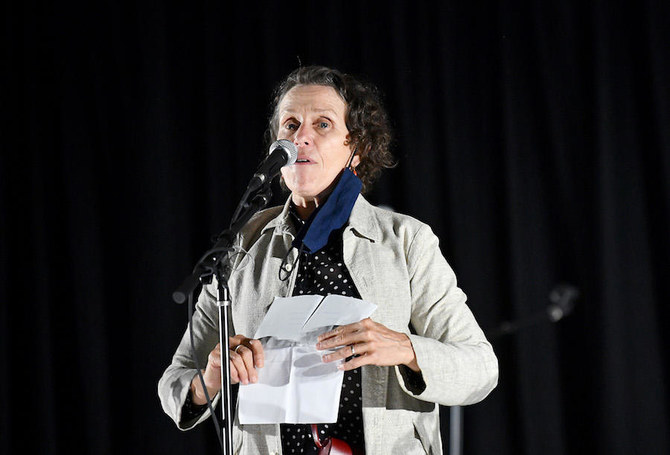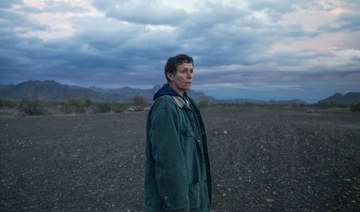VENICE, Italy: Chloe Zhao’s “Nomadland,” a recession-era road trip drama starring Frances McDormand, won the Golden Lion for best film Saturday at a slimmed-down Venice Film Festival, which was held against the backdrop of the coronavirus pandemic.
Zhao and McDormand appeared by video from the United States to accept the award, given virus-related travel restrictions made reaching the Lido in the Italian lagoon city difficult if not impossible for many Hollywood filmmakers and actors.
“Thank you so much for letting us come to your festival in this weird, weird world and way!” McDormand told the masked audience as the Italian marketing team for the film actually accepted the award. “But we’re really glad you let us come! And we’ll see you down the road!”
A favorite going into the awards season, “Nomadland” is screening at all the major fall film festivals in a pandemic-forged alliance involving the Venice, Toronto, New York and Telluride festivals.
Britain’s Vanessa Kirby won best lead actress for “Pieces of a Woman,” a harrowing drama about the emotional fallout on a couple after their baby dies during a home birth. Italy’s Pierfrancesco Fabino won best lead actor for “Padrenostro,” (Our Father), an Italian coming-of-age story that takes place after a terrorist attack in the 1970s.
“It’s the greatest honor of my life,” Kirby said afterwards from the red carpet, admitting that her knees were still shaking. “Cinema is everything to me, and so the fact that we’re all together, everybody, to support it and honor it is all I can ask for.”
Japanese director Kiyoshi Kurosawa won the Silver Lion for best director for “Wife of a Spy,” while the Silver Lion grand jury prize went to Mexico’s Michel Franco for his dystopian drama “Nuevo Orden.”
The Russian film “Dear Comrades!” about a 1960s era massacre in the former Soviet Union, won a special jury prize while Chaitanya Tamhane won best screenplay for “The Disciple,” about an Indian man’s pursuit to be a classical vocalist.
That the 10-day Venice festival took place at all was something of a miracle, given that northern Italy in late February became ground zero for Europe’s coronavivrus outbreak. The Cannes Film Festival was canceled and other big international festivals in Toronto and New York opted to go mostly online.
But after Italy managed to tame its infections with a strict 10-week lockdown, Venice decided to go ahead, albeit under safety protocols that would have previously been unthinkable for a festival that has prided itself on spectacular visuals and glamorous clientele.
Face masks were required indoors and out. Reservations for all were required in advance, with theater capacity set at less than half. The public was barred from the red carpet and paparazzi, who would normally chase after stars in rented boats, were given socially distanced positions on land.
While it’s too soon to say if the measures worked, there were no immediate reports of infections among festival-goers and compliance with mask mandates and social distancing appeared to be high.
“We were a little bit worried at the beginning, of course,” said festival director Alberto Barbera. “We knew that we had a very strict plan of safety measures and we were pretty sure about that, but you never know.”
Hong Kong director Ann Hui almost didn’t make it after she couldn’t get on her flight because of virus border restrictions. In the end, she arrived to collect her Golden Lion Lifetime Achievement Award and to see her out-of-competition film “Love After Love” make its world premiere.
Movie lovers applauded Venice’s effort and the symbolic significance of the world’s oldest film festival charting the path forward.
“It’s a moment of rebirth for everyone, for the whole world,” said Emma Dante, the Italian director of the in-competition film “The Macaluso Sisters.” “This festival is really an important moment of encounter, of beginning to dream again and be together again, even with the norms and following all the safety protocols.”
Film writer Emma Jones said aside from “a few teething problems” with the online reservation system, the festival went off better than she expected.
“It feels safe in there, it feels socially distanced,” she said of the venues.
Jones noted that the lineup of films lacked the usual Hollywood blockbusters — think “La La Land,” and “The Shape of Water” — that have used Venice as a springboard to Oscar fame. While the festival featured films from Iran, India, Australia and beyond, it was heavily European.
“This is a COVID festival. There’s no use pretending anything else,” Jones said.
But she added: “It would feel really off-note, I think, to have had a red carpet with screaming fans and celebrities walking down it and people talking about who wore what. Twenty-twenty is not the year for those kind of discussions.”
Instead, she said, Venice focused on the integrity of the films and the diversity of the countries represented.
“We were lucky to receive a lot of submissions from all over the world, and apart from a few missing titles from the Hollywood major film studios, most of the countries are represented in Venice and the quality of the lineup is really very high,” said festival director Barbera.
Chloe Zhao’s ‘Nomadland’ wins top prize at Venice Film Fest
https://arab.news/23mdg
Chloe Zhao’s ‘Nomadland’ wins top prize at Venice Film Fest
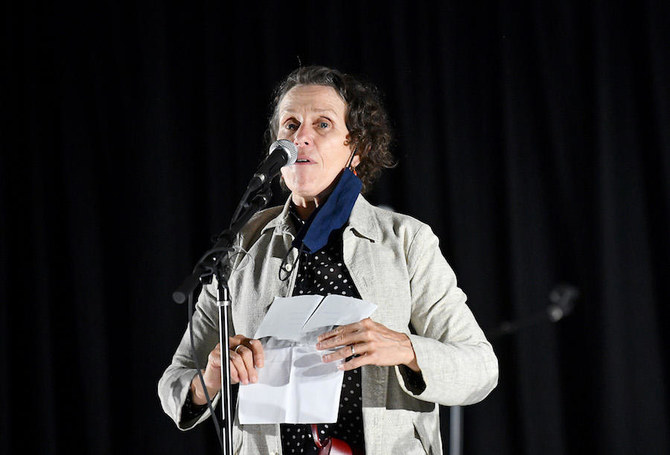
- Zhao and McDormand appeared by video from the United States to accept the award
- A favorite going into the awards season, “Nomadland” is screening at all the major fall film festivals in a pandemic-forged alliance involving the Venice, Toronto, New York and Telluride festivals
An enduring bond: A Jordanian photographer has turned his focus on two of the Arab world’s most beloved creatures

- Tariq Dajani’s first photographic exhibition of the horse and falcon series is on display at Ahlam Gallery in Al-Olaya, Riyadh
- Arabian horses have been the subject of songs and poetry praising their individual and physical qualities down through the ages
RIYADH: The Arabian horse and hunting falcon are important historical and cultural symbols for the Arab world, both ancient and modern.
Now a Riyadh gallery is highlighting this enduring bond with a series of portrait studies of both creatures by Tariq Dajani, a Jordanian photographer and printmaker.
Arabian horses have been the subject of songs and poetry praising their individual and physical qualities down through the ages.
However, Dajani, an owner of Arabians, chose to reflect his love of these creatures through photography and artworks.

Over the years he spent many sessions photographing horses in his native Jordan, as well as the UAE and Saudi Arabia. Later, toward the end of the project, he added the hunting falcon, another symbol of cultural heritage and pride among Arabs.
Dajani’s first photographic exhibition of the horse and falcon series is on display at Ahlam Gallery in Al-Olaya, Riyadh.
Entitled “Drinkers of the Wind,” the exhibition is the result of 16 years’ work creating portraits of these magnificent creatures.

Dajani told Arab News that he is delighted to be able to display his work in Saudi Arabia, “a country that is deeply connected to the horse and the falcon.”
Ahlam Gallery is the perfect place to showcase these artworks, he added.
Dajani’s treatment of his subjects is not in the usual natural or romantic manner. Instead, and this is partly what sets his art apart, he uses a studio portrait approach, where he takes his studio to the stables or falcon sheds, and spends time carefully working on portrait studies of the creatures.
“My aim is to find a connection of sorts with the horse or the birds,” he said. “I am not interested in documenting the creature; I try to go deeper, to express something emotionally if I can.
“I was living in Sweden when I decided to photograph the Arabian horse. So I had to return to the Middle East, and I started with Jordan, my home country.
“The way I approach the work is to present the horse on a backdrop where all my focus — and thus the viewers of the final picture — will be on the animal itself and not on the environment that it is in.”

While photographing in Jordan, Dajani met Princess Alia Al-Hussein, eldest daughter of the late King Hussein of Jordan. He presented some of his work to her, and received her enthusiastic approval.
Princess Alia gave him permission to photograph the horses of the Royal Jordanian Stud, and has continued to support his work over the years, opening his first two exhibitions in Jordan.
“I had access to some of the most beautiful horses in Jordan when I first started my project. My first exhibition solely of Jordanian Arabians was a great success,” Dajani said.
“Encouraged by the reception, and by now totally absorbed in this project, I went to Dubai, then Abu Dhabi, then Saudi Arabia, where I was presented with some of the most magnificent Arabian horses to photograph. Along the way, I introduced portrait studies of the hunting falcon. They, too, are strikingly beautiful and have a special place in Arab culture and heritage.
“I will always remain very grateful to Princess Alia for her initial support, and to many others for encouraging the work and opening doors for me along the way.”

One of his most striking photographs shows two mares bringing their heads together in a gentle greeting.
“This incredible and totally unanticipated greeting happened while I was photographing at the King Abdulaziz Arabian Horse Center in Dirab, south of Riyadh. The two mares were led out onto my backdrop studio space from opposite sides, and when they approached each other, they gently and courteously touched their heads as if to say hello,” he said.
“It was so special. No one had ever witnessed this before. We all held our breath as we watched in amazement. I frequently think that it would be nice if these sensitive, clever creatures could teach us humans a little bit of gentleness and respect.”
Dajani’s exhibition features high-quality photographic color prints, and a smaller collection of photogravure prints, produced by manually pulling an inked metal plate, engraved with the photographic image, through a traditional printing press — a slow and difficult process that produces prints with a special feel and texture.
Moroccan director Asmae El-Moudir joins Cannes’ Un Certain Regard jury
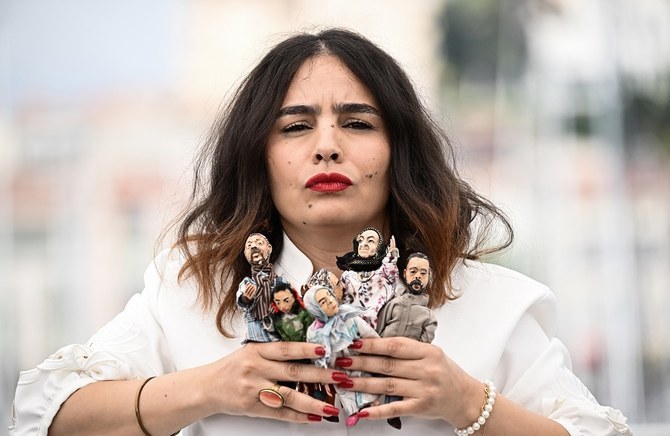
DUBAI: The Cannes Film Festival announced on Thursday that Moroccan director, screenwriter and producer Asmae El-Moudir will be part of the Un Certain Regard jury at the 77th edition of the event, set to take place from May 14-25.
She will be joined by French Senegalese screenwriter and director Maïmouna Doucouré, German Luxembourg actress Vicky Krieps and American film critic, director, and writer Todd McCarthy.
Xavier Dolan will be the president of the Un Certain Regard jury.
The team will oversee the awarding of prizes for the Un Certain Regard section, which highlights art and discovery films by emerging auteurs, from a selection of 18 works, including eight debut films.
El-Moudir is the director of the critically acclaimed film “The Mother of All Lies.”
The movie took the honors in the Un Certain Regard section, as well as winning the prestigious L’oeil d’Or prize for best documentary at the festival in 2023. The film explores El-Moudir’s personal journey, unraveling the mysteries of her family’s history against the backdrop of the 1981 bread riots in Casablanca.
El-Moudir is not the only Arab joining the Cannes team.
Moroccan Belgian actress Lubna Azabal this week was appointed the president of the Short Film and La Cinef Jury of the festival. The La Cinef prizes are the festival’s selection dedicated to film schools.
Second Ritz-Carlton Reserve in Saudi Arabia planned for Neom
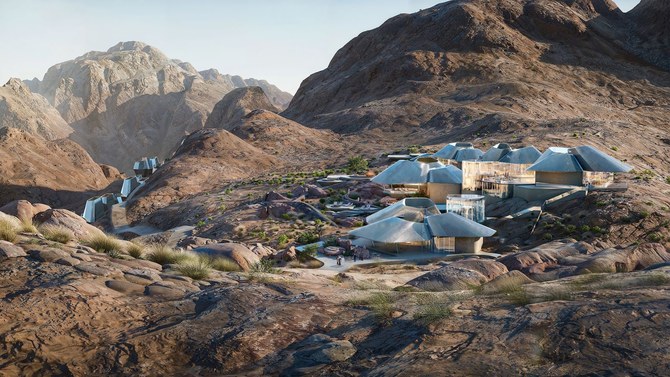
DUBAI: Marriott International, Inc. announced on Thursday that it has signed an agreement with Neom to open its second Ritz-Carlton Reserve in Saudi Arabia.
The hotel is anticipated to open in Trojena, a year-round mountain destination located in the northwest region of the country.
The resort is expected to feature 60 expansive one-to-four-bedroom villas. Plans also include a range of amenities including a spa, swimming pools and multiple culinary venues.
Chadi Hauch, the regional vice president of Lodging Development Middle East, Marriott International said in a statement: “Together with Neom, we look forward to bringing this ultra-luxury experience to Trojena. This signing also marks an important addition to our portfolio in Saudi Arabia where we continue to see a strong demand for our luxury brands.”
“Trojena is a rare destination, and we are delighted that Ritz-Carlton Reserve has hand-picked the mountains of Neom for their next property. Together we will create an experience that can’t be recreated anywhere else. Our visitors and residents will experience a sanctuary that will capture the magic of Saudi Arabia, embracing ultimate luxury in an unforgettable location,” executive director and Trojena region head Philip Gullett said in a statement.
Trojena, one of the flagship developments within Neom, is being developed and positioned as a year-round adventure sports destination that will include activities such as skiing, water sports, hiking and mountain biking. It will also include apartments, chalets, retail, dining, entertainment, leisure, sports and recreational facilities, and other hospitality offerings, including a W Hotel and a JW Marriott Hotel.
Ritz-Carlton Reserve currently boasts a collection of only six properties in destinations including Thailand, Indonesia, Puerto Rico and Mexico.
The Arab world at the Venice Biennale: Artists explore themes of identity, immigration, history
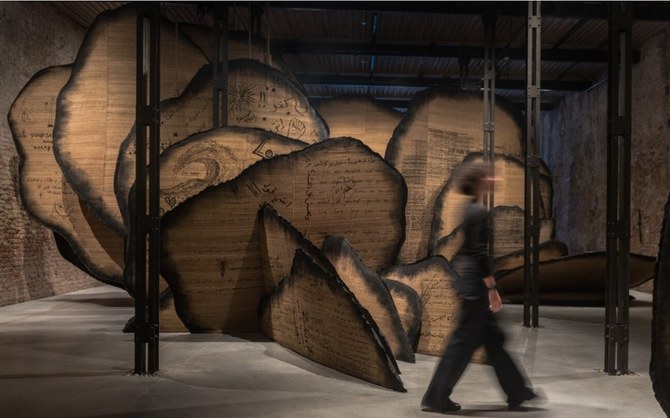
VENICE: No event in the international art scene is more anticipated, or debated, than the Venice Biennale. This year’s edition, “Foreigners Everywhere,” curated by Adriano Pedroso from Brazil, features 331 artists and 86 nations, including four Gulf countries as well as Lebanon and Egypt.
Saudi Arabia
Women’s voices chanting in unison fill the air of the Saudi Pavilion at Venice this year. “Shifting Sands: A Battle Song” was created by Saudi artist Manal AlDowayan, and hundreds of women from across the Kingdom participated in its creation. The exhibition, which includes large-scale installations in the form of desert roses filled with writing and drawings by the Saudi female participants whom AlDowayan worked with, aims to showcase the evolving role of women in the Kingdom while also striving to dispel media narratives that have long defined them. The chanting is derived from traditional battle songs once performed by Saudi men before they went into battle. Here they are chanted by women in a powerful chorus of strength and resilience, backed by recordings of the wind passing through sand dunes. The work, AlDowayan tells Arab News, “is about change, subtle changes — like those of a sand dune — the surface changes, but the core stays the same.”

UAE
Emirati artist Abdullah Al-Saadi is presenting “Sites of Memory, Sites of Amnesia” at the National Pavilion of the United Arab Emirates. It’s an introspective show consisting of drawings, sculptures, paintings and installations charting Al-Saadi’s travels around his homeland. “Traveling and understanding the natural world around me has always been an important part of my work,” Al-Saadi, who has even used rocks from the Emirates as his ‘canvas’ for some of the works, told Arab News. “Through this presentation in Venice, I hope visitors will enjoy tracing the travels I have taken over the past few years and also think about the world around us, and our place within it.”
Visitors will also be presented with gifts: maps and scrolls in colorful traditional chests from the region, which will be removed and presented to guests by actors from the UAE.
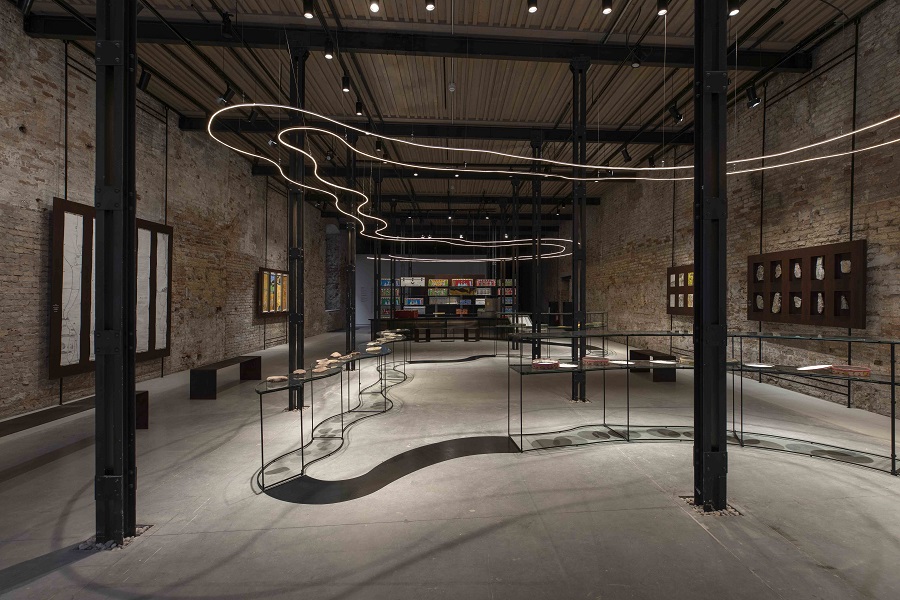
Qatar
While Qatar doesn’t have a national pavilion at the biennale, it is presenting “Your Ghosts Are Mine: Expanded Cinemas, Amplified Voices” — a group show of films by artists from across the Arab world, Africa and South Asia, as well as video installations from the collections of Mathaf: Arab Museum of Modern Art and the Art Mill Museum (scheduled to open in 2030). All the films were backed by the Doha Film Institute.
“For me, it was important to show movies reflective of the theme of the biennale — so, revolving around immigration, foreigners, personal diaries and self-portraits and stories from women — all coming from independent (artists) in the Global South, whose voices are not always shared,” the Paris-based curator Matthieu Orlean told Arab News.
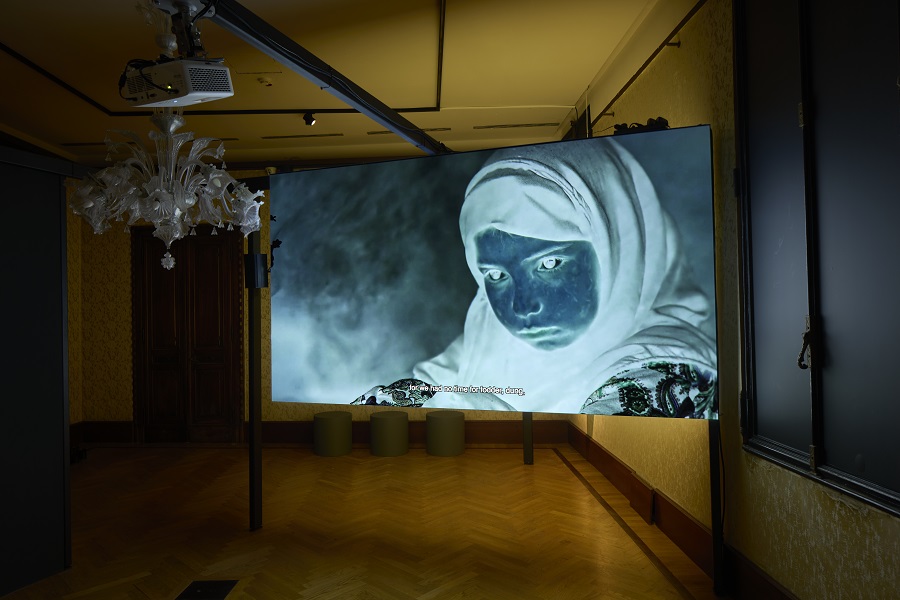
Egypt
Alexandrian-born artist Wael Shawky has created “Drama 1882,” a 45-minute film for which he also composed the music, for Egypt’s national pavilion, which — in the first week of the biennale at least — has proved to be one of the most popular pavilions at this year’s event.
The film is based around Egypt’s nationalist Urabi revolution against imperial influence in the late 19th century and Shawky uses historical and literary references as starting points from which to weave together a story that fuses fact, fiction and fable, while also exploring national, religious and artistic identity.
“I worked with performers who enacted a play in a theater for the film,” Shawky told Arab News. “The film strives in part to connect the idea of history to drama — drama regarding the connection to catastrophe and drama regarding cynicism. I like to analyze the authenticity of history, especially Egyptian history. When one makes films about history there is this gap between truth and myth.”

Lebanon
Lebanese artist Mounira Al-Solh’s multimedia installation “A Dance with Her Myth” combines drawing, painting, sculpture, embroidery, video, and audio, and guides viewers through ancient Phoenicia. The piece, Al-Solh explains to Arab News, is inspired by the tale of Europa, the daughter of a Phoenician king who was abducted from the city of Tyre in Lebanon by the Greek god Zeus, who had transformed himself into a white bull to trick her into riding him, then took her off into the sea.
“The (work) pays tribute to the ancient multicultural heritage of Lebanon,” Al-Solh says.
In the center of the pavilion is an unfinished boat, that Al-Solh says references “the tension that women still face today, despite their emancipation.”
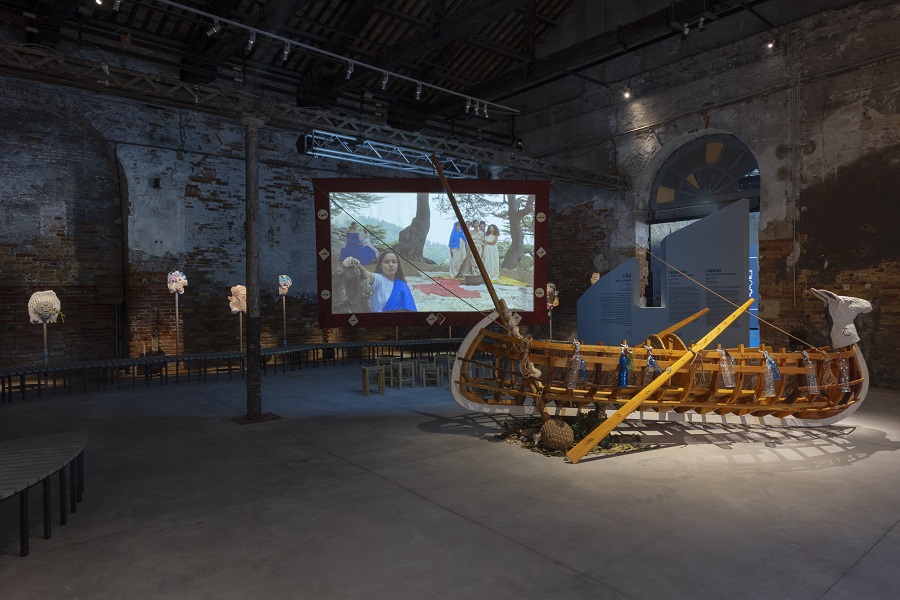
Oman
Oman’s second participation in the biennale, is an exhibition titled “Malath — Haven.” It includes work from five Omani contemporary artists: Ali Al-Jabri, Essa Al-Mufarji, Sarah Al-Aulaqi, Adham Al-Farsi and Alia Al-Farsi (who also curated the show). “We used the word ‘haven’ in the title because, since antiquity, foreigners — including the Romans, Portuguese and Indians — have visited Oman,” Alia Al-Farsi told Arab News. The works on display — from Al-Farsi’s own colorful and expressive mixed-media murals (such as “Alia’s Alleys,” pictured here) to Al-Aulaqi’s “Breaking Bread,” which includes a large sculpture of a niqab made from silver spoons — reflect both traditional and contemporary life in Oman.
“As an Omani creative with an international background, my aim was for the exhibition to serve as a sanctuary for visitors and travelers, allowing stories to unfold and intertwine, mirroring how our country finds its richness in intercultural dialogue,” the curator said in a statement.
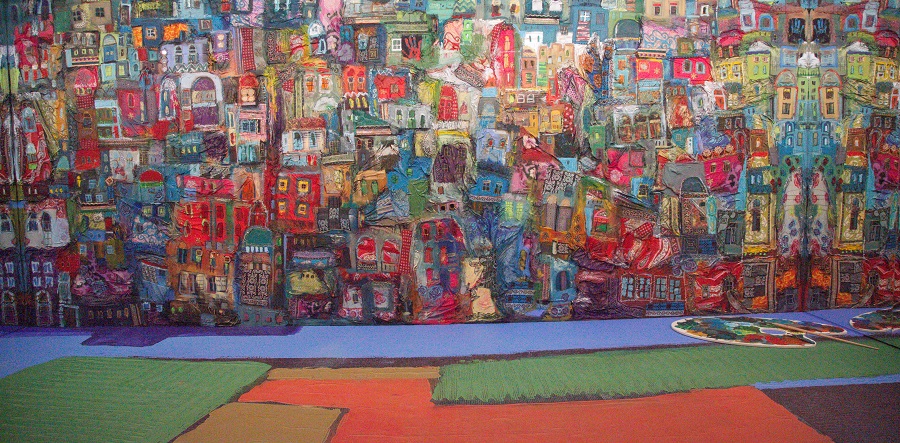
Arab-American Heritage Month: Sama Alshaibi — ‘I’m trying to change this idea of what an Arab woman is’
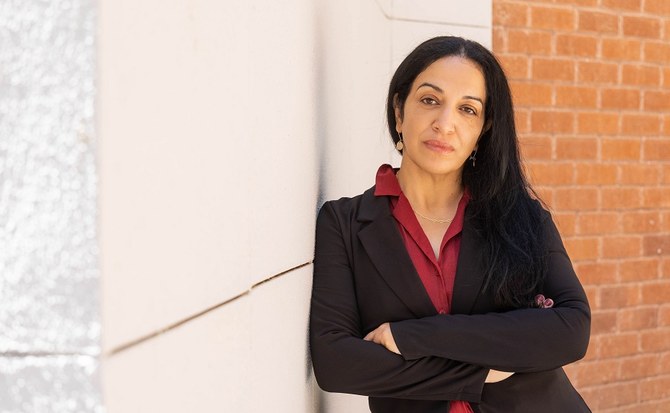
DUBAI: The fourth in this year’s series focusing on contemporary Arab-American artists in honor of Arab-American Heritage Month.
Born in Basrah to an Iraqi father and a Palestinian mother, Sama Alshaibi is an Arizona-based professor and artist who has mostly devoted her 20-year career to video, photography and performance art.
During the Iran-Iraq war of the Eighties, Alshaibi and her family moved around the region, living in Saudi Arabia, the UAE, and Jordan, before eventually settling in the American Midwest when she was 13 years old.
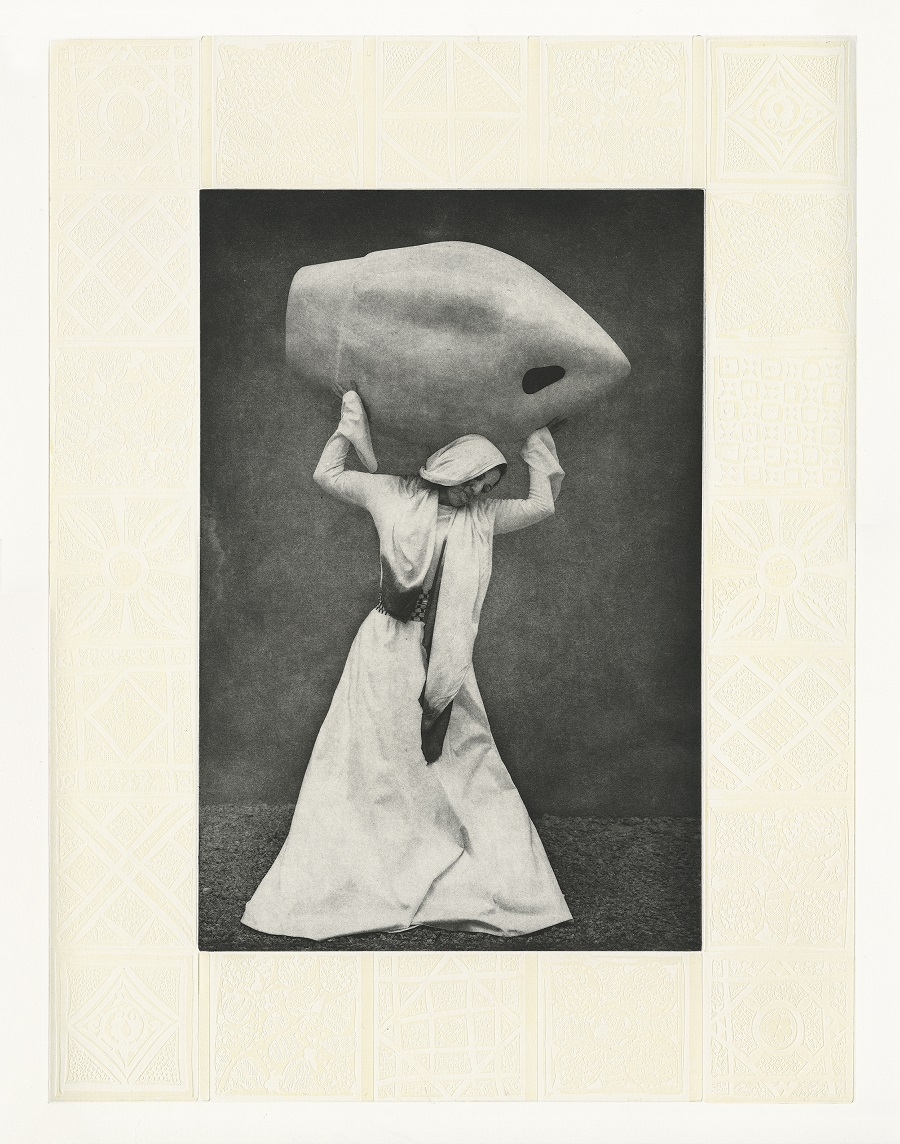
“Growing up in the United States was strange. We were a ‘different’ family in Iowa and there wasn’t a lot of diversity. But I grew up in a place with nice people,” Alshaibi tells Arab News from Bellagio, Italy, where she is doing a residency at the Rockefeller Foundation.
But she also says there were obstacles, mainly formed by major political events that impacted her. “It was challenging, because of where I’m from,” she says.
Alshaibi’s work is largely inspired by her Arab roots. “Arts were so revered in my family,” she says. “I don’t even know if I would be making art if it wasn’t for my heritage.” It was her father, an avid photographer, who taught her to use a manual camera. She aspired to become a photojournalist herself — inspired by 20th-century African-American photographers, notably Carrie Mae Weems and Lorna Simpson, who documented Black culture in their imagery.
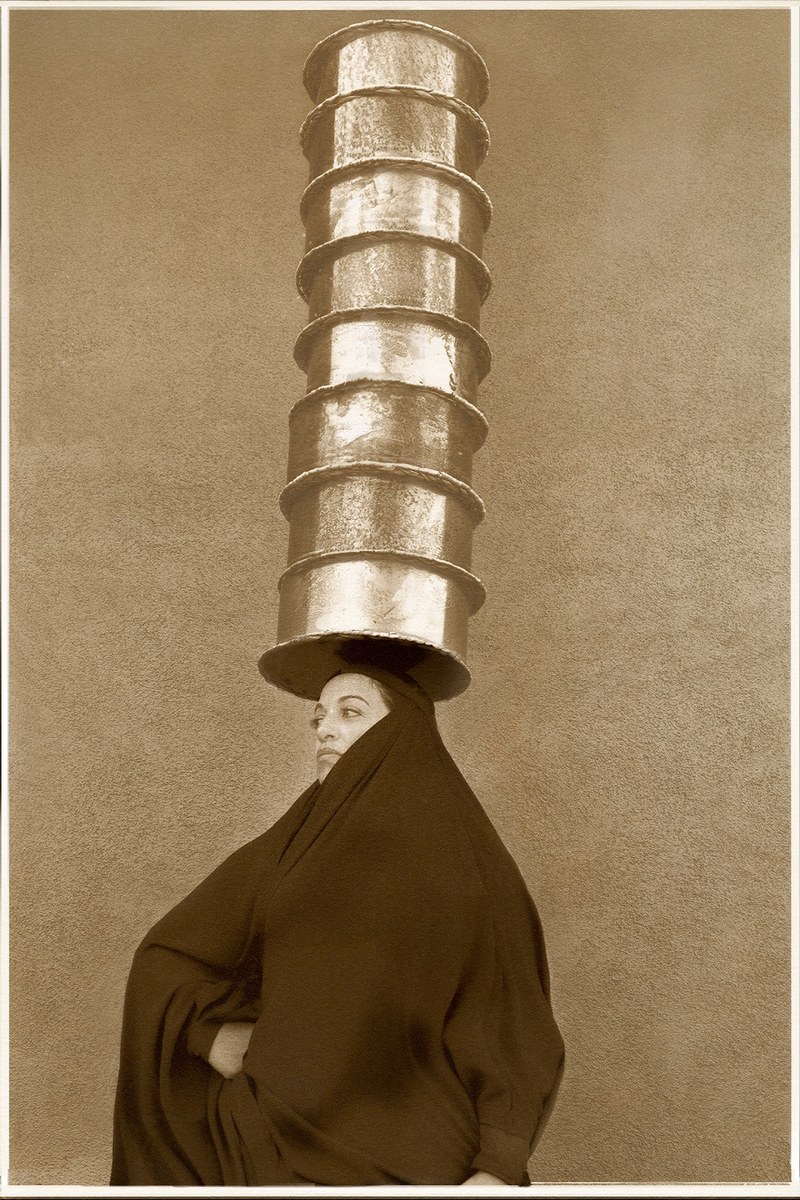
Many of her images are portraits of herself wearing, for example, traditional Middle Eastern garments, referencing romanticized Orientalist portrayals of women, and in the end, challenging them.
“I’m trying to change this idea of what you think an Arab woman is,” she explains. “I started seeing the power of communication, of taking political or social issues and using your body, your performance, your environment, to address them.”
One of Alshaibi’s best-known series is called “Carry Over,” in which she photographed herself carrying large objects (or Orientalist props), such as a tower of container tins or a water vessel, above her head. The images poetically show a woman’s endurance and comment on a collective history, affected by colonialism and cultural loss.
“I’ve always been interested in the notion of ‘aftermath’ — what happens after the destruction of your environment,” explains Alshaibi. “It gets you to the question of what we can’t hold onto anymore.”


